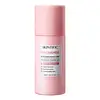What's inside
What's inside
 Key Ingredients
Key Ingredients

 Benefits
Benefits

 Concerns
Concerns

 Ingredients Side-by-side
Ingredients Side-by-side

Water
Skin ConditioningButylene Glycol
HumectantNiacinamide
SmoothingGlycerin
HumectantGlycereth-26
HumectantPropylene Glycol
HumectantPentylene Glycol
Skin ConditioningTranexamic Acid
Astringent1,2-Hexanediol
Skin ConditioningHydroxyacetophenone
AntioxidantDiphenyl Dimethicone
EmollientTriethylhexanoin
MaskingAlpha-Arbutin
AntioxidantPolyglyceryl-10 Oleate
Skin ConditioningHydrogenated Lecithin
EmulsifyingCentella Asiatica Extract
CleansingCeramide Eos
Skin ConditioningCeramide Ns
Skin ConditioningCeramide NP
Skin ConditioningCeramide AP
Skin ConditioningCeramide EOP
Skin Conditioning3-O-Ethyl Ascorbic Acid
Skin ConditioningAllantoin
Skin ConditioningPEG-40 Hydrogenated Castor Oil
EmulsifyingDisodium EDTA
Tamarindus Indica Seed Polysaccharide
Skin ConditioningPPG-5-Ceteth-20
EmulsifyingSodium Polyacryloyldimethyl Taurate
Emulsion StabilisingFructose
HumectantTocopheryl Acetate
AntioxidantAroma
Diglucosyl Gallic Acid
Maltose
MaskingSodium Chloride
MaskingTrehalose
HumectantCitric Acid
BufferingSodium Hydroxide
BufferingGlucose
HumectantWater, Butylene Glycol, Niacinamide, Glycerin, Glycereth-26, Propylene Glycol, Pentylene Glycol, Tranexamic Acid, 1,2-Hexanediol, Hydroxyacetophenone, Diphenyl Dimethicone, Triethylhexanoin, Alpha-Arbutin, Polyglyceryl-10 Oleate, Hydrogenated Lecithin, Centella Asiatica Extract, Ceramide Eos, Ceramide Ns, Ceramide NP, Ceramide AP, Ceramide EOP, 3-O-Ethyl Ascorbic Acid, Allantoin, PEG-40 Hydrogenated Castor Oil, Disodium EDTA, Tamarindus Indica Seed Polysaccharide, PPG-5-Ceteth-20, Sodium Polyacryloyldimethyl Taurate, Fructose, Tocopheryl Acetate, Aroma, Diglucosyl Gallic Acid, Maltose, Sodium Chloride, Trehalose, Citric Acid, Sodium Hydroxide, Glucose
Water
Skin ConditioningPEG-7 Glyceryl Cocoate
EmulsifyingGlycerin
HumectantButylene Glycol
HumectantDicaprylyl Carbonate
EmollientUndecane
EmollientTridecane
PerfumingSodium Carbomer
Emulsion StabilisingPolyglyceryl-10 Laurate
Skin ConditioningTocopherol
AntioxidantCetraria Islandica Extract
CleansingHydroxyacetophenone
AntioxidantPolyglyceryl-6 Dicaprate
EmulsifyingAlgae Extract
EmollientDisodium EDTA
Lecithin
EmollientMaltodextrin
AbsorbentPhenoxyethanol
PreservativeSodium Benzoate
MaskingPotassium Sorbate
PreservativeAroma
Water, PEG-7 Glyceryl Cocoate, Glycerin, Butylene Glycol, Dicaprylyl Carbonate, Undecane, Tridecane, Sodium Carbomer, Polyglyceryl-10 Laurate, Tocopherol, Cetraria Islandica Extract, Hydroxyacetophenone, Polyglyceryl-6 Dicaprate, Algae Extract, Disodium EDTA, Lecithin, Maltodextrin, Phenoxyethanol, Sodium Benzoate, Potassium Sorbate, Aroma
 Reviews
Reviews

Ingredients Explained
These ingredients are found in both products.
Ingredients higher up in an ingredient list are typically present in a larger amount.
Aroma refers to an ingredient, or mixture of ingredients, that impart or mask a flavor.
The name is slightly confusing. This is because INCI associates aroma with flavor instead of smell.
Here is the official definition from the The International Cosmetic Ingredient Dictionary and Handbook:
“Aroma is a term for ingredient labeling used to identify that a product contains a material or combination of materials normally added to a cosmetic to produce or to mask a particular flavor.”
INCI shows the only purpose of aroma to be "flavouring".
However, due to regulation differences, some companies may use aroma in place of parfum.
In Canada, this ingredient only has to be listed in concentrations above 1%.
Learn more about AromaButylene Glycol (or BG) is used within cosmetic products for a few different reasons:
Overall, Butylene Glycol is a safe and well-rounded ingredient that works well with other ingredients.
Though this ingredient works well with most skin types, some people with sensitive skin may experience a reaction such as allergic rashes, closed comedones, or itchiness.
Learn more about Butylene GlycolDisodium EDTA plays a role in making products more stable by aiding other preservatives.
It is a chelating agent, meaning it neutralizes metal ions that may be found in a product.
Disodium EDTA is a salt of edetic acid and is found to be safe in cosmetic ingredients.
Learn more about Disodium EDTAGlycerin is already naturally found in your skin. It helps moisturize and protect your skin.
A study from 2016 found glycerin to be more effective as a humectant than AHAs and hyaluronic acid.
As a humectant, it helps the skin stay hydrated by pulling moisture to your skin. The low molecular weight of glycerin allows it to pull moisture into the deeper layers of your skin.
Hydrated skin improves your skin barrier; Your skin barrier helps protect against irritants and bacteria.
Glycerin has also been found to have antimicrobial and antiviral properties. Due to these properties, glycerin is often used in wound and burn treatments.
In cosmetics, glycerin is usually derived from plants such as soybean or palm. However, it can also be sourced from animals, such as tallow or animal fat.
This ingredient is organic, colorless, odorless, and non-toxic.
Glycerin is the name for this ingredient in American English. British English uses Glycerol/Glycerine.
Learn more about GlycerinHydroxyacetophenone is antioxidant with skin conditioning and soothing properties. It also boosts the efficiency of preservatives.
This ingredient is not irritating or sensitizing.
Water. It's the most common cosmetic ingredient of all. You'll usually see it at the top of ingredient lists, meaning that it makes up the largest part of the product.
So why is it so popular? Water most often acts as a solvent - this means that it helps dissolve other ingredients into the formulation.
You'll also recognize water as that liquid we all need to stay alive. If you see this, drink a glass of water. Stay hydrated!
Learn more about Water